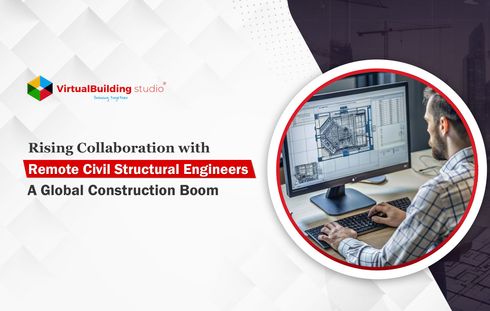
Let’s look at the breakdown of BIM Level 2:
Why was BIM Level 2 Developed?
In May 2011, a construction strategy was published by the UK Government aimed towards reducing the cost of public sector assets by 20%, by the year 2016.
To achieve this, the government has mandated all stakeholders to work on a collaborative basis and share their respective information on a common environment.
To achieve BIM Level 2, it is required to have a fully collaborative 3D BIM model along with all the project and assets information documented in a digital format.
What is BIM Level 2?
As per the NBS, Building Information Modeling (BIM) Level 2 represents a significant milestone in the evolution of collaborative digital practices within the construction industry. At its core, BIM Level 2 is characterized by the creation and exchange of shared 3D models containing intelligent data throughout a project’s lifecycle.
In this collaborative environment, multiple disciplines and stakeholders contribute to and utilize a Common Data Environment (CDE), promoting transparency and efficiency.
BIM Level 2 emphasizes standardized processes, data consistency, and interoperability, enabling improved coordination, reduced errors, and enhanced decision-making. It marks a shift towards a more integrated and collaborative approach to construction projects, setting the stage for greater efficiency, reduced costs, and improved project outcomes
Key Advantages of Embracing BIM Level 2 in Construction
Enhanced Collaboration:
BIM Level 2 fosters seamless collaboration among stakeholders, including architects, engineers, contractors, and clients. The shared digital platform allows real-time collaboration, reducing communication gaps and enhancing overall project coordination.
Integrated Information:
One of the fundamental principles of BIM Level 2 is the integration of comprehensive information within the digital model. It goes beyond 3D geometry, incorporating valuable data such as cost estimates, schedules, and specifications. This integrated approach facilitates better decision-making at every stage of the project.
Improved Project Control:
BIM Level 2 provides a robust framework for project control, offering better visibility into various aspects of construction. From managing timelines and resources to addressing potential clashes and conflicts, the level of control afforded by BIM enhances project predictability and success.
Clash Detection and Resolution:
The 3D models generated through BIM Level 2 allow for advanced clash detection. Identifying clashes early in the design phase helps prevent costly errors during construction. This proactive approach minimizes rework, saving time and resources.
Efficient Asset Management:
Beyond the construction phase, BIM Level 2 supports efficient asset management throughout the lifecycle of a building. It provides a centralized repository of information that can be utilized for maintenance, renovations, and future expansions.
Standardized Information Exchange:
BIM Level 2 adheres to standardized information exchange protocols such as Industry Foundation Classes (IFC). This standardization ensures that information can be seamlessly shared and understood across different software platforms, fostering interoperability.
Cost Savings:
The integrated and collaborative nature of BIM Level 2 contributes to significant cost savings. By reducing rework, improving project efficiency, and minimizing errors, construction projects can stay within budget and achieve a higher return on investment.
Regulatory Compliance:
Many regulatory bodies and governments are recognizing the benefits of BIM Level 2 and incorporating its adoption into construction standards. Embracing BIM helps ensure compliance with evolving industry regulations and requirements.
Requirements for Implementing BIM Level 2
To successfully implement Building Information Modeling (BIM) Level 2, several key requirements must be met. BIM Level 2 is characterized by collaborative working, information sharing, and the use of shared digital models for project delivery.
Development of Information Models:
The core of BIM Level 2 involves the development of information models that serve as digital representations of the physical and functional characteristics of a built asset. These models should not only be comprehensive but also capable of referencing, federating, or exchanging information with other relevant models, ensuring a holistic view of the project.
Employer’s Information Requirements (EIR):
A detailed Employer’s Information Requirements document is crucial for successful BIM Level 2 implementation. The EIR outlines the project-specific information deliverables and the standards to which these deliverables should adhere. It should also include clear definitions and decision points to guide the entire project team.
BIM Execution Plan (BEP):
The BIM Execution Plan is a comprehensive document that outlines the project’s digital strategy. It should include details on assigned roles and responsibilities, standards, methods, and procedures for BIM implementation. The BEP ensures that all project stakeholders are aligned with the BIM processes and workflows.
Common Data Environment (CDE):
A central component of BIM Level 2 is the provision of a Common Data Environment. The CDE is a digital space where all project-related information, documentation, and models are stored, managed, and accessed by authorized team members. It facilitates seamless collaboration and ensures that everyone is working with the latest and most accurate data.
MIDP Matrix Aligned with Project Program:
The Master Information Delivery Plan (MIDP) is a matrix that details what information is required, who is responsible for delivering it, and when it is needed throughout the project lifecycle. It should be aligned with the overall project program to ensure that information is delivered in a timely manner to support decision-making at each project stage.
Standards and Protocols:
Adherence to industry standards and protocols is vital for BIM Level 2 implementation. This includes utilizing open standards such as Industry Foundation Classes (IFC) for information exchange. Consistent application of standards ensures interoperability and data consistency across various software platforms.
Continuous Review and Improvement:
BIM Level 2 is not a one-time implementation but an ongoing process. Regular reviews should be conducted to assess the effectiveness of BIM processes and identify areas for improvement. This iterative approach ensures that the project team remains adaptive and responsive to changing project dynamics.
Conclusion
BIM Level 2 represents a paradigm shift in the construction industry, emphasizing collaboration, information integration, and enhanced project control. As the industry continues to evolve, the adoption of BIM Level 2 is becoming not just a competitive advantage but a necessity for those aiming to deliver successful and sustainable construction projects.




